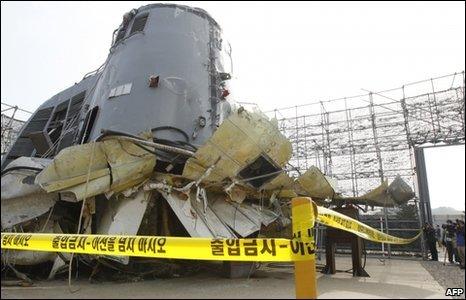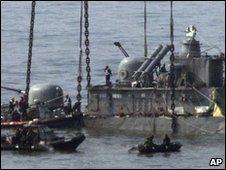How South Korean ship was sunk
- Published

Teams have salvaged the wreckage of the Cheonan from the sea bed
It might seem odd that it has taken a six-week-long investigation to produce proof of something as catastrophic as a torpedo strike on a warship.
When it finally came, it was in dramatic form.
A few bits of rusty scrap metal, unveiled in front of the assembled reporters at a press conference marking the publication of the investigation report.
Ever since the South Korean warship, the Cheonan, was split in half by an explosion and began sinking in the darkness with the loss of 46 lives, North Korea has been the prime suspect.
But why has it been so difficult to prove?
Stealth is the name of the game in submarine warfare.
It is entirely plausible that a ship, on routine patrol in its own shallow waters, would not pick up any signs of an enemy sub, or even a torpedo fired from one, on its sonar system.
So the fact that North Korea was not caught in the act has meant that the investigation team has had to embark on a painstaking and slow process, attempting to piece together what happened by examining the shattered wreck of the ship, salvaged in two pieces from the sea bed.
It was announced early on that the Cheonan had been hit by an external "non-contact" explosion.
That ruled out a simple collision with a rock, or an internal malfunction of the ship's own weapons systems.
Whatever sank it had exploded underwater, close to the hull of the ship but not in contact with it.
That is exactly the way that many torpedoes are designed to work, because exploding a few feet away from the ship causes a far more devastating blow than a direct hit.
Sea search
The trouble for the investigation team was that many sea mines are designed to explode in exactly the same way.
Could the Cheonan have been sunk as the result of an accidental collision with an unexploded mine left over from the Korean War perhaps?

The Cheonan was lifted from the sea bed in April
It was crucial to find direct evidence of the type of weapon involved.
To that end the South Korean navy even designed its own special nets and they have been dragging them, up to eight times a day, across the seabed close to the site of the sinking.
Just five days ago, they found what they were looking for - the propellers, a propulsion motor and a steering section of a torpedo, a perfect match for a model known to be manufactured and exported by North Korea.
The markings, in Korean script, are said to be consistent with those on a previously obtained model.
It was these fragments that were put on display at the news conference. They were clear evidence that the weapon used with such devastating effect was a 1.7 ton torpedo with a net explosive weight of 250kg, and apparent proof of North Korea's involvement.
There is other evidence of course.
The investigation report says that a number of small submarines, escorted by a support ship, left a North Korean naval base in the Yellow Sea a few days prior to the attack and returned a few days after it took place.
The investigation itself was given an added air of impartiality by the presence of 24 foreign experts from America, Australia, Britain and Sweden. They are all said to support the conclusions reached.
To what end?
The only big question that remains is why?
Using a submarine to launch an unprovoked attack on another country's warship is such an extraordinary act of aggression with such serious potential consequences.
And despite the difficulties in obtaining proof after the event as outlined above, such an action certainly runs a substantial risk of detection.
Why would North Korea have taken such a calculated risk, and for what purpose?
Some observers have suggested that it may have been a simple act of retaliation.
The Cheonan sank close to the disputed sea boundary between North and South Korean territorial waters, along which the two navies have clashed a number of times in the past decade.
The most recent incident, last November, left a North Korean ship in flames, with reported casualties amongst the crew.
But torpedoing a warship would be a very dramatic response indeed.
Another theory suggests that the incident is a worrying indication of the tensions within the North Korean power structure.
Perhaps the order was given by the ageing and ailing North Korean leader to keep the military on side. Or perhaps the military were acting alone.
The speculation will continue, as will the debate about the appropriate response.
But for now, one thing seems to be beyond reasonable doubt, the Cheonan was sunk by North Korea, and South Korea has the evidence to prove it.